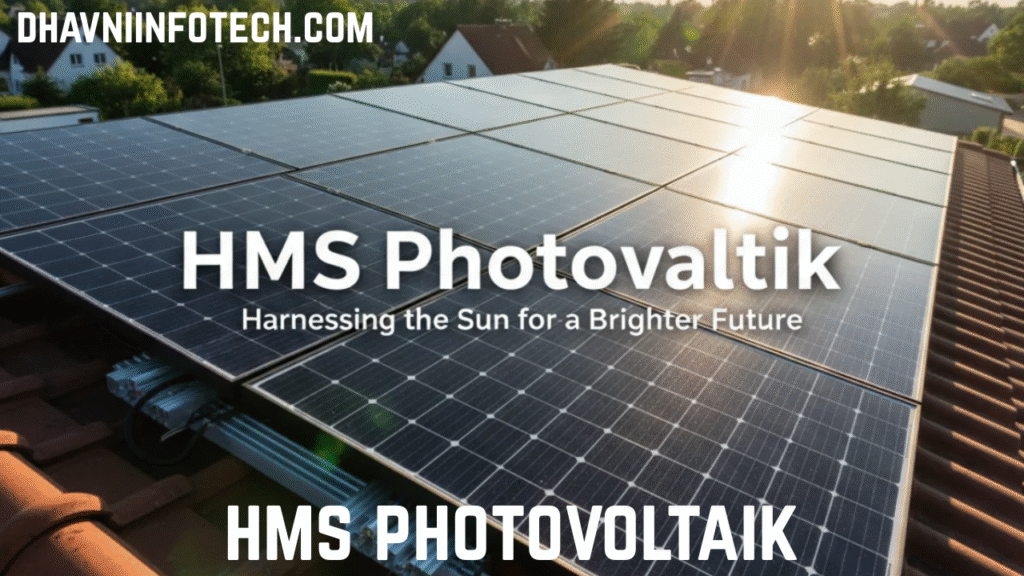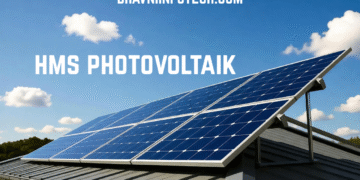HMS Photovoltaik represents a new era in the development of solar energy technology, merging innovation, smart control systems, and advanced photovoltaic efficiency into a single platform. The term “HMS Photovoltaik” combines the precision of modern hardware management systems (HMS) with the sustainable potential of photovoltaics, which are devices that convert sunlight directly into electricity. In an age where renewable energy is no longer an option but a necessity, HMS Photovoltaik provides a smart and integrated approach to managing solar power more effectively. This system is designed to ensure that energy conversion, monitoring, and distribution occur at maximum efficiency while maintaining environmental sustainability. The growing global demand for clean energy has made HMS Photovoltaik a leading concept in both commercial and residential applications, bridging the gap between traditional solar systems and intelligent energy management.
Technological Advancements Behind HMS Photovoltaik

The success of HMS Photovoltaik lies in the combination of cutting-edge photovoltaic cells and intelligent monitoring technologies. Unlike older solar systems that operate passively, HMS Photovoltaik includes integrated sensors and data analytics tools that track energy production, temperature, sunlight intensity, and system performance in real time. These intelligent monitoring features allow operators to adjust parameters and optimize electricity output under changing weather conditions. Many systems include microinverters or power optimizers, ensuring that each solar panel functions independently for improved reliability. This advancement means that shading or partial obstruction of one module no longer reduces the output of the entire array. The HMS Photovoltaik system also incorporates IoT-based interfaces that connect to mobile devices, allowing users to analyze their energy usage, forecast power generation, and reduce system losses. Such technology ensures long-term sustainability and cost-effectiveness, creating a new benchmark for the solar power industry.
Design and Engineering Principles of HMS Photovoltaik Systems
At the heart of HMS Photovoltaik is its engineering design, which focuses on durability, adaptability, and ease of installation. The system typically includes high-performance solar modules mounted on robust frames that can withstand extreme weather conditions. Its structure is engineered to enhance solar exposure throughout the day, ensuring maximum energy absorption. The integration of HMS components means that all electrical circuits are optimized to reduce resistance and energy loss. These designs often use advanced semiconductor materials with higher photon absorption rates, which significantly increase the conversion efficiency of sunlight into electricity. HMS Photovoltaik systems are also modular, making them ideal for both small-scale rooftop installations and large industrial solar farms. The flexible nature of their design allows seamless expansion when additional capacity is required, ensuring that users can scale their systems without complete reinstallation.
Efficiency and Performance Benefits of HMS Photovoltaik
The key advantage of HMS Photovoltaik lies in its exceptional efficiency and operational performance. By integrating smart monitoring systems and precision-engineered photovoltaic modules, the system consistently achieves higher conversion rates compared to traditional solar setups. Many HMS Photovoltaik systems can deliver efficiencies above 20%, a figure that reflects remarkable progress in solar technology. The system’s real-time monitoring capabilities enable quick detection of performance issues such as dust accumulation or temperature fluctuations, allowing for immediate corrective action. In addition, these systems reduce downtime by providing predictive maintenance alerts before technical faults occur. This proactive management not only enhances performance but also extends the operational lifespan of each photovoltaic module. Ultimately, HMS Photovoltaik delivers maximum energy output per square meter of installed area, making it a preferred choice for both residential and industrial energy producers seeking sustainable profitability.
Environmental Impact and Sustainability of HMS Photovoltaik

HMS Photovoltaik is designed to contribute directly to environmental preservation and carbon reduction goals. As the global community faces urgent challenges related to climate change, renewable energy sources like HMS Photovoltaik have become essential solutions. The system operates silently, produces no emissions during use, and helps reduce reliance on fossil fuels. Its high efficiency ensures that fewer panels are needed to generate equivalent power, thereby minimizing the physical footprint on land and materials. Moreover, HMS Photovoltaik modules are increasingly manufactured from recyclable and eco-friendly materials, reducing environmental impact even during the production phase. The use of automated energy control mechanisms further supports sustainable living by balancing supply and demand efficiently. As more industries adopt HMS Photovoltaik, the overall energy mix shifts toward cleaner alternatives, promoting a greener economy and a healthier planet for future generations.
Applications and Integration of HMS Photovoltaik in Different Sectors
The versatility of HMS Photovoltaik allows it to be implemented across multiple sectors, from residential rooftops to large-scale industrial facilities. In homes, these systems provide clean, reliable electricity that can power appliances, heating systems, and electric vehicles. The integration of HMS technology ensures that homeowners can track daily and monthly power usage, promoting conscious energy management. In the industrial sector, HMS Photovoltaik systems are used to offset high energy consumption, stabilize power costs, and reduce operational emissions. Agricultural facilities benefit greatly from solar-powered irrigation and greenhouse systems, while commercial buildings utilize HMS Photovoltaik to achieve energy independence. Additionally, government and municipal projects adopt this technology to support public infrastructure, such as street lighting and remote energy supply. This adaptability proves that HMS Photovoltaik is not just a technological innovation but a flexible energy solution for the modern world.
Economic Benefits and Long-Term Value of HMS Photovoltaik

One of the most appealing aspects of HMS Photovoltaik is its potential for long-term financial savings. While the initial investment in solar infrastructure can be considerable, the system’s efficiency and low maintenance costs lead to significant economic advantages over time. HMS Photovoltaik systems typically offer a return on investment within a few years, after which the electricity generated is virtually free. The integration of intelligent monitoring reduces repair and maintenance costs by detecting potential faults before they cause system failures. Moreover, the lifespan of HMS Photovoltaik components can exceed 25 years, providing decades of reliable performance. For businesses, the predictable energy costs help in financial planning and reduce exposure to fluctuating electricity prices. As energy regulations evolve and carbon taxes increase, adopting HMS Photovoltaik becomes an economically strategic decision that aligns profitability with sustainability.
Challenges and Future Prospects of HMS Photovoltaik
Despite its many advantages, HMS Photovoltaik also faces challenges that influence its global adoption. The cost of advanced components, such as high-efficiency cells and IoT-based monitoring systems, can increase the initial setup expenses for smaller users. Additionally, installation requires skilled technicians who understand both photovoltaic engineering and digital energy systems. However, continuous research and innovation are addressing these limitations, leading to more affordable and accessible solutions. Future developments are expected to improve energy storage integration, enabling HMS Photovoltaik to work seamlessly with battery systems and smart grids. As artificial intelligence becomes more prevalent, future systems will be capable of learning from energy consumption patterns and automatically adjusting output to optimize efficiency. The evolution of HMS Photovoltaik is set to redefine the way humanity interacts with renewable energy, moving closer to a world powered entirely by sustainable sources.
Global Growth and Adoption of HMS Photovoltaik Systems
The worldwide shift toward renewable energy has accelerated the demand for HMS Photovoltaik systems. Countries across Europe, Asia, and North America have recognized the value of integrating smart technologies into their solar energy infrastructure. The combination of government incentives, public awareness, and technological advancement has made HMS Photovoltaik one of the most promising sectors within the renewable energy market. In regions with high solar radiation, such as the Mediterranean and parts of Asia, these systems have already achieved widespread adoption. The emphasis on local energy production and independence has further encouraged communities to invest in HMS Photovoltaik for both residential and commercial applications. As international policies continue to prioritize carbon neutrality and green development, the global trajectory of HMS Photovoltaik points toward exponential growth in the coming decades.
Conclusion
In conclusion, HMS Photovoltaik represents a powerful fusion of innovation, sustainability, and technological intelligence. It embodies the transformation of traditional solar energy systems into dynamic, data-driven platforms capable of optimizing energy production and consumption in real time. With its vast applications, environmental benefits, and economic advantages, HMS Photovoltaik stands as a cornerstone of the global renewable energy revolution. Its continued evolution will shape the way societies generate and use electricity, guiding humanity toward a more sustainable and efficient future.
FAQs
Q1: What makes HMS Photovoltaik different from regular solar systems?
HMS Photovoltaik integrates intelligent monitoring and control systems that optimize performance, whereas traditional solar systems function passively.
Q2: Can HMS Photovoltaik be used for both homes and industries?
Yes, the modular design of HMS Photovoltaik makes it suitable for residential, commercial, and industrial applications.
Q3: How long does an HMS Photovoltaik system last?
Most systems have an operational life of over 25 years with minimal maintenance, depending on environmental conditions and usage.
Q4: Does HMS Photovoltaik help reduce electricity costs?
Absolutely. The system’s efficiency and long lifespan lead to significant cost savings and a quick return on investment.
Q5: Is HMS Photovoltaik environmentally friendly?
Yes, HMS Photovoltaik reduces carbon emissions, operates silently, and contributes to global sustainability efforts through clean energy generation.
Read More: Understanding ovppyo and Its Expanding Role in the Digital World






















